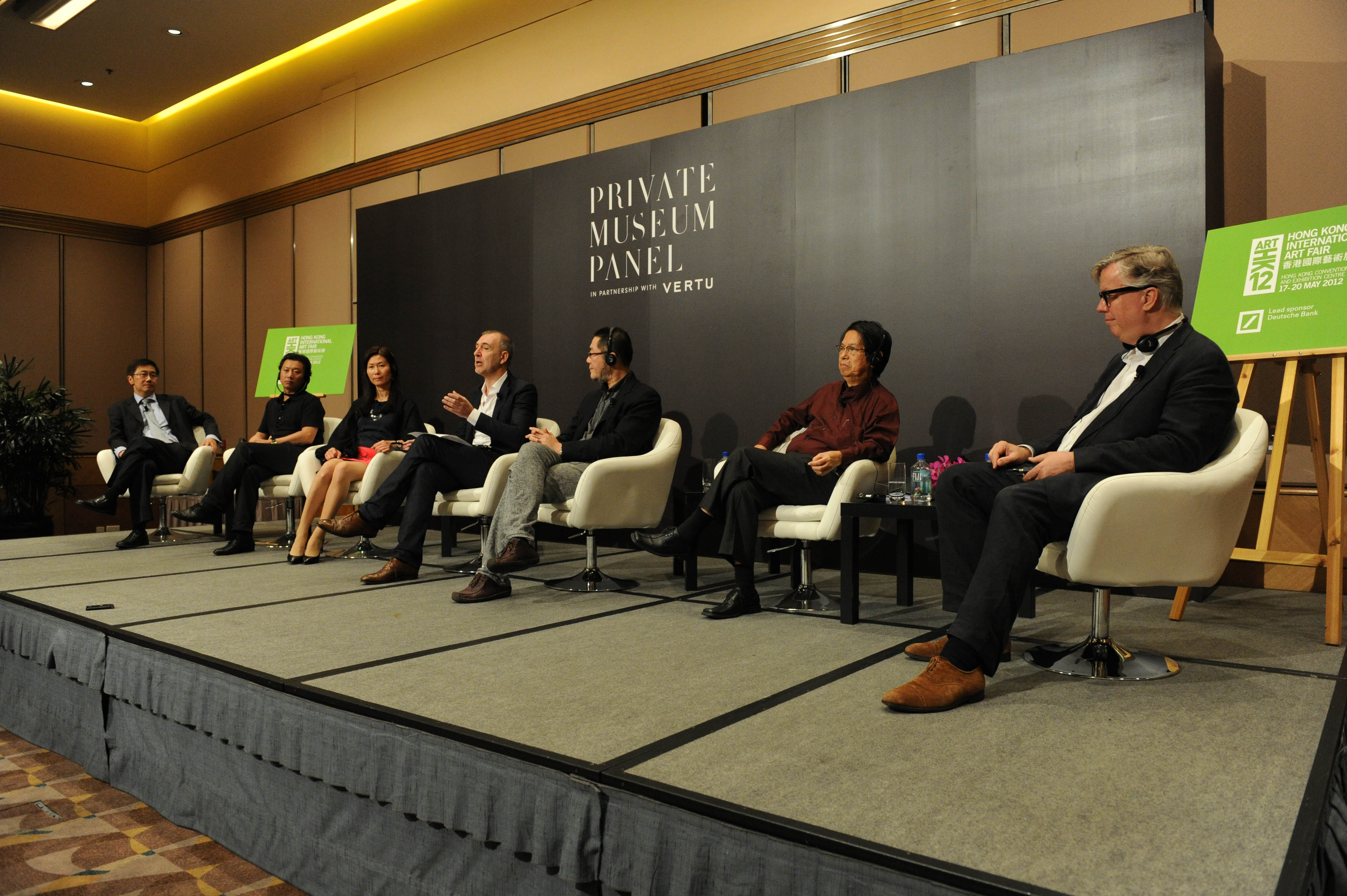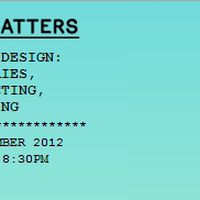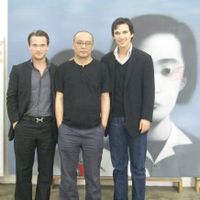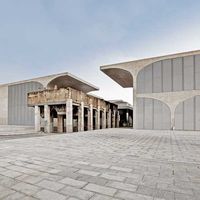Rethinking Museums | Private Museum Forum at Art HK 12

culture360.org contributor Bharti Lalwani presents the fifth in a series of conversations with Directors and Head Curators of Private Museums as well as Art Advisors, to discuss the phenomenon of private art museums in Asia. The following is an overview of a recent forum regarding the role of such museums in the region which took place at Art HK on 17th May 2012. This afternoon forum complimented a morning session where museum directors- from both private and public spheres, engaged in discussions on major issues of museology behind closed doors.
The Panel, presided by former Director of Institute of Contemporary Art (London) Philip Dodd, consisted of six speakers:
Wang Huangsheng, Director of CAFA Gallery, Beijing, and former Director of Guangdong Museum of Art
Li Bing, owner of Beijing He Jing Yuan Art Museum
Dr Oei Hong Djien, owner of OHD Museum, Magelang, Indonesia
Kian Chow Kwok, Senior Advisor to the National Art Gallery, Singapore
Wang Wei, collector and owner of the Dragon Art Museum, Shanghai, due to open November 2012
Lars Nittve, former Director of Tate Modern, London, and Executive Director of M+, a major museum of Contemporary Art being developed in the West Kowloon Cultural District of Hong Kong
The very first Private Museum Panel, framed as “a salon-style discussion open to the public in which owners and directors of museums across the Asia Pacific region, both from the private and public sectors, will discuss current developments in the museum scene”, promised to offer a rare opportunity for open and transparent dialogue. However, this session, punctuated by the moderator's own personal views and interjections, only served up a mere snapshot of a complex and rapidly evolving comprehension of what constitutes “a museum in Asia” and what it takes to sustain one.
Speakers Li Bing and Wang Wei represented their private museums- Beijing He Jing Yuan Art Museum and Dragon Art Museum Shanghai respectively, while Wang Huangsheng, Director of CAFA Gallery and a well-known academic, represented the Public institutions. Kwok Kian Chow, former Director of The National Art Gallery turned Advisor to the soon-to-open Singapore public museum (and recently appointed advisor to the Yellow River Arts Centre in Yinchuan, China) and Lars Nittve, the Director of the M+ Kowloon Cultural District spoke from the Public perspective. Lastly, Dr. Oei Hong Djien represented his private museum in Magelang.
Note that three of the speakers are from China, one from Hong Kong (technically “China”) and one each from Singapore and Indonesia, therefore making this forum rather China-centric as opposed to the promised representation of the “Asia Pacific region”. The lack of diverse perspectives for the sake of a dynamic discussion- the non-inclusion of Private Museums owners from India, Korea or the Phillipines for example- only made for a one-eyed view on significant issues.
Perhaps language too, presented a challenge since the three speakers from China did not communicate in English; and even though there were translators on hand (translating via headphones issued to every audience member) the discussion trudged along at times, extinguishing any spark of a spontaneous repartee amongst the panellists. Crucial points on ethics, transparency and the future of such private enterprises were indeed touched upon but not discussed in-depth. One could also sense how careful and guarded the speakers were being, considering their diplomatic response.
Bearing in mind such broad factors of influence, an open conversation was understandably not achievable within the timeframe of an hour; however, the moderator's trivial approach and his inability to critically question and engage his panellists beyond their superficial answers, made for a rambling, redundant forum, void of any crucial conclusion.
Dodd opened the discussion with “Why do you think museums are so important in Asia right now?” after which he quickly took questions from the audience instead of delving deeper into matters of museology which include cohesive collection building, curatorial planning and public outreach and education programming. (The quotes below are only the highlights extracted from the main transcript).
Wang Huangsheng: Museums in general are gaining prominence in Asia but in China we face a great deal of issues. Many museums have been cut off in some ways from history. One is supposed to build a collection which is consistent with history or art history but then for various reasons we were unable to build such a collection. Currently we are trying to supplement this with our research. Many Chinese museums do a number of shows but they are hardly systematic in their approach in collecting. I work for a public museum where building a collection which truly reflects its country's history is our challenge.
Oei Hong Djien: Indonesia has a population of about 250 million. We have a number of very talented modern and contemporary artists but we don't have a national museum and the government is still not taking any steps in that direction, so we as responsible private collectors must think about fulfilling this role- especially at this point in time when the world art scene is focused on Asia. Indonesia is the largest country in Southeast Asia and ranks third after China and India.
Li Bing: We have had a habit of collecting in China and especially since the opening up of China thirty years ago we have returned to that habit -and this has a lot to do with our fundamental economic development.
Wang Wei: In my twenty years of building a collection, I did not intend to open any museum- I was just a housewife- A friend wanted to organize an auction and was looking for someone to work with and I recommended myself as the manager for this auction company and I started collecting since then. Beginning with Chinese ink paintings and through conversations with experts I understood that there was a lot of interest in art from the so call Red Era. An American lady in the US was in fact collecting such pieces from auctions and I thought,’ why don’t I start collecting in a systematic manner as well which would reflect the history of china from that era'. After a number of years I decided to showcase this collection and it was actually very well received.
I also worked with the head of the China National museum to publish a book and the experts observed that it was indeed a systematic collection. This Red Classic collection is an inheritance of our history and after that I decided to establish a private museum and started scouting for locations. The name of our museum is Dragon art Museum so we hope that we can open in the year of the Dragon by November.
Kwok Kian Chow: A museum is a package of sorts of all the aspects of what we consider “culture”. Given the rich history and heritage of Asia, it is only natural this should be given a platform of a museum. [...] 60 years have passed since the Second World War and we now have gathered enough resources to build our history, build the infrastructure for our heritage.
Lars: Yes! I'd like to build on what KC said. To understand what is happening in Asia now, one could look at the early 20th century of, say, the USA. Suddenly there was this boom of museums, every town, every city built private and public museums and of course the time was right- when there is such diversity there is a need to understand society and culture- there was a real need to understand history and create a space for discourse. And it is of course about “face”; it is about showing that we have succeeded; in Asia now we want to say that we have reached that point of success and we want to show it to others.
At this point an audience member is invited to ask her question: “Having a dedicated collector and founder of a private museum is one thing but what about the future of such museums when it comes down to the next generation?”
LB: China, after several decades of development has a number of wealthy people and they feel a sense of responsibility to the people. This is a discussion we have just begun, I began collecting and then established a gallery in 2006...now I asked my daughter if she could learn Museum Management but her enthusiasm isn’t the same as mine. I have an art background and I love art but she has different interests. Therefore we need a professional curator and staff to manage our collection- If I cannot find an inheritor, then I must have a board of trustees.
OHD: We need the funds and expertise to run these spaces and maybe besides that, the political situation in your country or even government regulations. Museums in Indonesia are funded by the main business of the owner which might not at all relate to art. In my case, my collection was built from tobacco money- As long as people are still smoking its fine, but if people are not permitted to smoke, then I have a problem! Then in that case, I will have to sell a painting or two in order to sustain my museum.
Also expertise is very scarce in Indonesia and I think we have to work very hard on this aspect, on the other hand, if we have a government which doesn't allow us to exhibit a certain kind of art, then that is a problem beyond our control.
LN: Well actually I'd like to point out that most of the museums in the West (US), which we have come to know and love began as some version of a private museum, they turned public at one point or another, generations down the line. In fact I've had a number of conversations with people who ask if it is possible to build a museum collection from scratch. So we need to rethink what we are building for our future. Many collectors are looking at the long term view of building a museum and it is a daunting task. Maybe a collector could find a museum and place their collection in their trust. So I don’t think there is one solution but there are several approaches to this and a number of private museums being set up now may become public museums in the next hundred years.
WH: What we are concerned about in China is the policy and political system and if the museum could function within a framework wherein we could continue developing exhibition programing. So we are actually in a very preliminary stage where we can accommodate the anarchic as well as the functional aspects of a museum from one generation to the next. We must look for our successors in the next generation who could well advance and sustain our work. In China, we have a relatively short history of development- especially with respect to the museum system which means that we still do not have any fiscal policies, management measures or the best practices in order to carry on building our museums into the next generation.
Culture360: I have 2 questions, the first for Dr. Oei: You have handed the baton over to the next generation- your daughter-in-law is now the Director of your new, third museum space in Magelang, unveiled just last month (April 5th). What is her vision of how she would like to run this new space? How does her vsion differ from yours?
And the second question open to the panel: As and when these new Private Museums emerge and establish themselves, the potential of these museums to operate as platforms for cultural exhange is exponential....So a private museum in India- and I wish Kiran Nadar were on this panel as well- could host a show from Indonesia from Dr. Oei's collection and so on and so forth. So are we at a stage where we are having such conversations?
Unfortunately before Dr. Oei can respond, these questions are promptly trivialized and deflected by the reductive moderator who turns to invite other questions. An audience member proceeds to raise the question of ethics with regard to a private museum to which only Lars' reply addresses the flipside to collectors having their own museums.
LN: I think it is important to remember that private museums are private, they can do whatever, they can be whatever and can have exactly the same ambitions as a public museum- to write a certain history to present to the public, to create a platform for discussion and so forth while others can be totally obsessed with a specific type of art to show to their peers. You cannot talk about them as a group, some museums are absolutely against the idea of being 'for' the public or as a form of public service and we cannot package it like that.
Dr. Oei, belatedly gets the opportunity to respond to the earlier question and thus concludes the session on the Private Museum:
OHD: My sons are the heads of their family and must concentrate on the business, I've asked my daughter-in-law to run the museum! But our private museum derives its vision from the collection which may have its own criteria. But in my case, because Indonesia does not have a National Museum so I have attempted to fill this gap with my collection – which, as you have seen, is very history-oriented and academic.
Similar content
posted on
22 Sep 2011
from - to
03 Dec 2012 - 03 Dec 2012
20 May 2011
17 May 2011
posted on
21 Apr 2014





